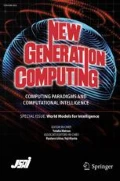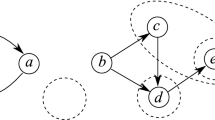Abstract
This paper deals with deductive databases in linear logic. The semantics of queries, views, constraints, and (view) updates are defineddeclaratively in linear logic. In constrast to classical logic, we can formalise non-shared view, transition constraints, and (view) updates easily. Various proof search strategies are presented along with an algorithm for query evaluation from a bottom-up direction. An additional advantage is that the associated meaning of a given relation can be defined in terms of the validity of a legal update in a given relation. We also defined formally the update principles and showed the correctness of the update translation algorithms. In this approach, we provide virtual view updates along with real view updates, and view DELETIONs are special cases of view REPLACEMENTs. This permits three transactional view update operations (INSERTION, DELETION, REPLACEMENT) in comparison to only (INSERTION, DELETION) in most existing systems.
Similar content being viewed by others
References
Abiteboul, S. and Vianu, V., “Procedural Languages for Database Queries and Updates,”J. Comput. Syst. Sci., 41(2), pp. 181–229, 1990.
Andreoli, J. M. and Pareschi, R., “Linear Objects: Logical Processes with Built-In Inheritance,”New Generation Computing, 9, pp. 445–473, 1991.
Asperti, A., Ferrari, G. L. and Gorrieri, R., “Implicative Formulae in the ‘Proofs as Computations’ Analogy,” inPrinciples of Programming Languages (P. Hudak, ed.), ACM, pp. 59–71, 1990.
Atzeni, P. and Torlone, R., “Updating Datalog Databases,” inNext Generation Information Systems Technology, Kiew, Soviet Union,LNCS 504, Springer-Verlag, Berlin, pp. 347–362, 1990.
Codd, E. F., “Recent Investigations in Relational Data Base Systems,”Information Processing, 74, North-Holland Publishing Company, pp. 1017–1021, 1974.
Date, C. J.,An Introduction to Database Systems (5th ed.), Addison-Wesley, Reading, MA, 1990.
Date, C. J. and McGoveran, D., “Updating Union, Intersection, and Difference Views,” inRelational Database Writings (C. J. Date, ed.), Addison-Wesley, Reading, MA, pp. 1991–1994, 1995.
Fagin, R., Kuper, G. M., Ullman, J. D. and Vardi, M. Y., “Updating Logical Databases,” inAdvances in Computing Research, Vol. 3, JAI Press Inc., pp. 1–18, 1986.
Fouqueré, C. and Vauzeilles, J., “Linear Logic and Exceptions,”Journal of Logic and Computation, 4 (6), pp. 859–875, 1994.
Galmiche, D. and Perrier, G., “Automated Deduction in Additive and Multiplicative Linear Logic,” inTver ’92, LNCS 620, Springer-Verlag, Berlin, 1992.
Galmiche, D. and Perrier, G., “On Proof Normalisation in Linear Logic,”Theoretical Computer Science, 135, 1994.
Girard, J. Y., “Linear Logic,”Theoretical Computer Science, 50, pp. 1–102, 1987.
Girard, J. Y., “Logic and Exceptions: A Few Remarks,”Journal of Logic and Computation, 2(2), pp. 111–118, 1992.
Girard, J. Y., “Linear Logic: Its Syntax and Semantics,” inAdvances in Linear Logic (J. Y. Girard, Y. Lafont and L. Regnier, eds.), Cambridge University Press, 1995.
Gehlot, V. and Gunter, C. A., “Normal Process Representatives,” inProceedings of Fifth Symposium on Logic in Compute Science, Philadelphia, Pennsylvania, IEEE Computer Science Press, pp. 200–207, 1990.
Grant, J. and Minker, J., “Deductive Database Theories,”The Knowledge Engineering Review, 4, pp. 267–304, 1989.
Guessoum, A. and Lloyd, J. W., “Updating knowledge bases,”New Generation Computing, 8(1), pp. 71–89, 1990.
Hoare, C. A. R.,Communicating Sequential Processes, Prentice-Hall, 1985.
Hodas, J. S. and Miller, D., “Logic Programming in a Fragment of Intuitionistic Linear Logic,”Information and Computation, 110(2), pp. 327–365, 1994.
Kobayashi, N. and Yonezawa, A., “ACL: A Concurrent Linear Logic Programming Paradigm,” inProceedings of the International Symposium on Logic Programming (D. Miller, ed.), Vancouver, Canada, Oct. 1993, MIT Press, pp. 279–294, 1993.
Kowalski, R., “Databases Updates in the Event Calculus,”The Journal of Logic Programming, 12, pp. 121–146, 1992.
Lafont, Y., “Linear Logic Programming,” inWorkshop on Programming Logic, Göteborg, pp. 209–220, 1987.
Lafont, Y., “The Linear Abstract Machine,”Theoretical Computer Science, 59, pp. 157–180, 1988. Some corrections inVolume 62, pp. 327–328, 1988.
Laurent, D., Luong, V. P. and Spyratos, N.,Database Updating Revisited, DOOD’93, Arizona, USA,LNCS 760, Springer-Verlag, Berlin, 1993.
Lee, D. T. and Tsang, C. P., “Solving the Database Update Problem Using Linear Logic,” inProceedings of the 7th Australasian Database Conference (R. Topor, ed.), Melbourne, Australia, Jan. 29–30, 1996,Australian Computer Science Communications, 18(2), pp. 131–138, 1996.
Lincoln, P., “Linear Logic,”ACM SIGACT Notices, 23(2), pp. 29–37, 1992.
Lincoln, P., Mitchell, J., Scedrov, A. and Schankar, N., “Decision Problem for Propositional Linear Logic,”Annals of Pure and Applied Logic, 56, pp. 239–311, 1992.
Lincoln, P. and Scedrov, A., “First Order Linear Logic without Modalities is NEXPTIME-Hard,”Theoretical Computer Science, 135, pp. 139–154, 1994.
Lincoln, P. and Shankar, N., “Proof Search in First-order Linear Logic and other cut-free sequent calculi,” inNinth Annual Symposium on Logic in Computer Science (S. Abramsky, ed.), Paris, France, pp. 282–291, 1994.
Marti-Oliet, N. and Meseguer, J., “From Petri Nets to Linear Logic through Categories: A Survey,”Journal on Foundations of Computer Science, 2(4), pp. 297–399, 1991.
Manchanda, S. and Warren, D. S. A., “Logic-based Language for Database Updates,” inFoundations of Deductive Databases and Logic Programming (J. Minker, ed.), Morgan Kauffman, Los Altos, pp. 363–394, 1988.
Masseron, M., Tollu, C. and Vauzeilles, J., “Generating Plans in Linear Logic I: Actions and Proofs,”Theoretical Computer Science, 113(2), pp. 349–370, 1993.
McGoveran, D. and Date, C. J. “A New Database Design Principle,” inRelational Database Writings, 1991–1994 (C. J. Date, ed.), Addison-Wesley, Reading, MA, 1995.
Miller, D., “A Multiple-Conclusion Meta-Logic,” inProceedings, Ninth Annual IEEE Symposium on Logic in Computer Science, Paris, France, Jul. 4–7, 1994. IEEE Computer Society Press, pp. 272–281, 1994, to appear inTheoretical Computer Science.
Reiter, R., “On Specifying Database Updates,”The Journal of Logic Programming, 25(1), pp. 53–91, 1995.
Tammet, T., “Proof Search Strategies in Linear Logic,”Journal of Automated Reasoning, 12, pp. 273–304, 1994.
Teniente, E. and Olive, A., “The Events Method for View Updating,” inDeductive Databases, EDBT’92, LNCS 580, Springer-Verlag, Berlin, 1992.
Wagner, G., “A Database Needs Two Kinds of Negation,” inMFDBS 91, 3rd Symposium on Mathematical Foundations of Database and Knowledge Base Systems, Germany, May 1991,LNCS 495, Springer-Verlag, Berlin, 1991.
Harland, J. and Pym, D., “On Resolution in Fragments of Classical Linear Logic,” inLogic Programming and Automated Reasoning (LPAR’92), A. Voronkov, ed., St. Petersburg, Jul. 1992,LNAI 624, Springer-Verlag, Berlin, pp. 30–41, 1992.
Author information
Authors and Affiliations
Additional information
Dong-Tsan Lee, Ph.D.: He is a computer scientist in the Department of Computer Science at University of Western Australia, Perth, Western Australia, Australia. He received the B.S. and M.S. degrees from the Department of Computer Science at National Chiao-Tung University, Taiwan, in 1983 and 1985, respectively, and earned the Ph.D. degree from the Department of Computer Science at University of Western Australia. His research interests include database and artificial intelligence, linear logic, and real-time software engineering.
Chin-Ping Tsang, Ph.D.: He is currently an associate professor in the Department of Computer Science at University of Western Australia, Perth, Western Australia, Australia. He received the Ph.D. degree from the University of Western Australia. He was the head of the Department of Computer Science at the University of Western Australia from 1994 to 1997. His research interests include artificial intelligence, non-classicial logic and neural nets.
About this article
Cite this article
Lee, DT., Tsang, C.P. Linear logic for deductive databases. New Gener Comput 17, 201–228 (1999). https://doi.org/10.1007/BF03037436
Received:
Revised:
Issue Date:
DOI: https://doi.org/10.1007/BF03037436



